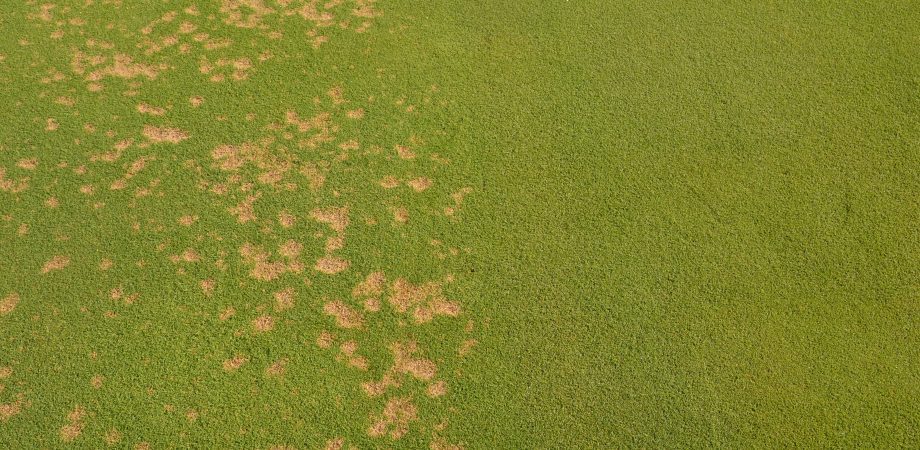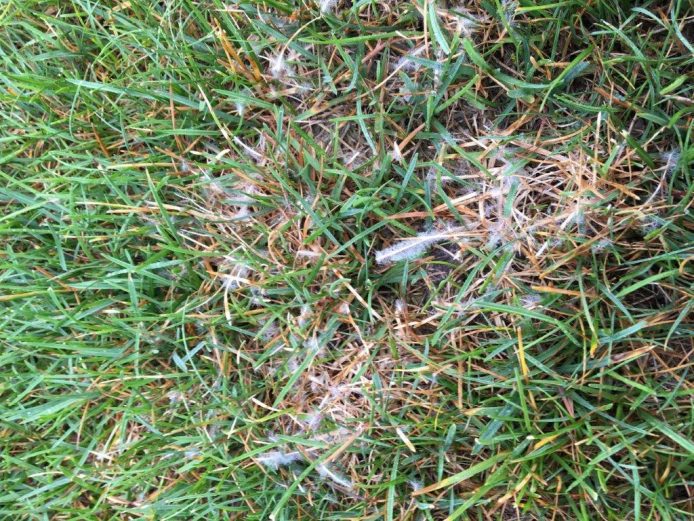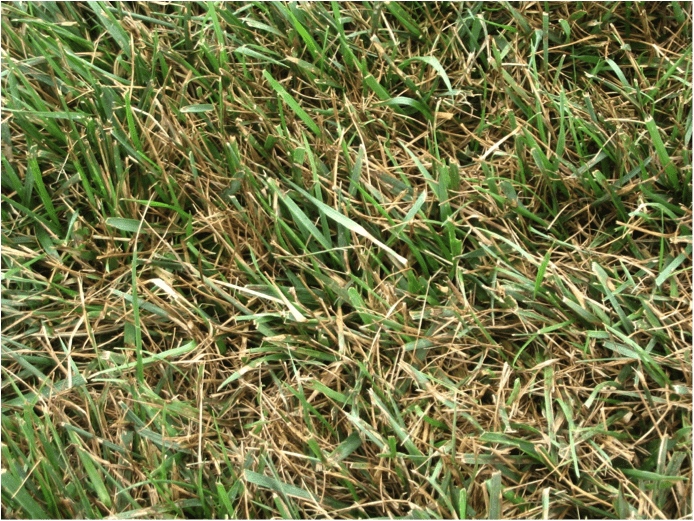FMC Q&A for Dollar Spot and Brown Patch

We asked Tina Bond, technical service manager with FMC Professional Solutions, a few questions about dollar spot and brown patch. Learn what the symptoms of dollar spot and brown patch are, when applications should begin, what happens if you miss your first app, and more in this Q&A.
Dollar Spot
What are the symptoms of dollar spot that we need to look out for?
Dollar spot is a foliar disease so the symptoms will appear on turfgrass leaves. The type of symptoms you see will depend on the mowing height of the turf. In higher cut turf you may see small tan-colored lesions with red to maroon margins expanding across the leaf blade. In lower cut turf you’ll see circular white to tan spots (hence the name ‘dollar spot’) approximately 1 inch in diameter which can coalesce into larger areas. One of the telltale signs of dollar spot is the presence of white mycelium on the leaf blades in the morning after heavy dew.

When should applications for the disease begin?
Environmental conditions that are conducive for development of dollar spot include:
- Can occur from late spring to fall depending on your location
- Air temperatures ranging from 60° to 85°F
- 10-12 hours of prolonged leaf wetness
- Heavy dew (when you typically see the fluffy, white mycelium)
- Wet, overcast weather
- Turfgrass that is stressed and deficient in nitrogen
Preventative applications are the most effective strategy for successful dollar spot control. Under high disease pressure, shorter application intervals and higher fungicide rates should be used. It is important to use between 1 – 2 gal/1000 ft2 spray volume for effective coverage.
What are the challenges we face when controlling dollar spot?
Dollar spot is costly and time-consuming to control if you’re not using a comprehensive approach to disease management. Due to the application frequency and cost of fungicides particularly in low cut turf, there are now documented cases of fungicide resistance with dollar spot. Resistance is not good for our industry because we end up losing these valuable tools over time. Designing a fungicide program that rotates modes-of-action will reduce the risk of resistance development.
If you miss your first application for dollar spot control, what should you do?
Don’t panic, but don’t delay! Products like Rayora fungicide have excellent curative effectiveness against dollar spot. As soon as you’re able, make the fungicide application based on label recommendations.
How many applications do you recommend we make to manage dollar spot and when?
Dollar spot control should be approached with a resistance management mindset that includes not only integrated turfgrass management practices, but rotation of fungicide modes of action. The number of applications and fungicide recommendations will really depend on your location (for timing) and the dollar spot pressure you’re facing. Fungicide labels will also indicate the number of maximum allowable applications or amount active ingredient per year. FMC would be happy to discuss the options with you!
What can we do to help our fungicides perform their best and keep dollar spot at a manageable level throughout the season?
The best defense against any disease is a healthy stand of turfgrass. If the turf is stressed in any way, it becomes more susceptible to attack by pathogens. By supplying the turf with adequate moisture and nutrients; mowing at the right height and making sure the turf is as healthy as it can be can reduce the impact of all manner of pests.
If you do have to apply a fungicide, always apply fungicides preventatively when the dollar spot is actively growing for peak effectiveness. Following a model (like Smith-Kerns), your own local weather patterns and knowing the history of where outbreaks have occurred can help you pinpoint your fungicide choice and application timing.
Brown Patch

What are the symptoms of brown patch that we need to look out for?
Brown patch symptoms vary depending on the mowing height of the turf. On higher cut turfgrass, white mycelium may be observed on the leaf blades under humid conditions. Tan lesions with dark reddish margins can be observed on the leaf blades. As these lesions coalesce infected turfgrass becomes blighted creating large irregular-shaped patches. Mycelium is typically not observed on short cut turfgrass like golf course putting greens. Instead, symptoms develop into tan to brown irregular-shaped patches up to 1 ft in diameter with purple margins referred to as a “smoke ring” pattern. The smoke ring indicates the pathogen is actively growing and action should be taken to control the spread.
When is brown patch most active and severe?
Brown patch begins to develop in summer with air temperatures around 65°F however more severe outbreaks will develop when air temperatures are 77°F or higher. Since there could be survival structures in the ground, soil temperatures are also important to consider. When soil temperatures exceed 60°F survival structures (sclerotia or mycelia) in the soil begin to grow and begin the disease cycle.
Irrigation and/or rainfall events and high relative humidity lasting for at least 10 hours are also required for disease development.
How many applications do you recommend we make to manage brown patch and when?
Rotation of modes of action for brown patch is always recommended. The number of applications and fungicide recommendations will really depend on your location (for timing) and the disease pressure you’re facing. Fungicide labels will also indicate the number of maximum allowable applications or amount active ingredient per year. FMC would be happy to discuss the options with you!
What are the challenges we face when controlling brown patch?
Brown patch control should be approached with a resistance management mindset that includes not only integrated turfgrass management practices, but rotation of fungicide modes of action. Managing turfgrass so it is healthy can help prevent disease from developing. As always, resistance management is critical in our industry so we can maintain efficacy and usage of fungicides. Designing a fungicide program that rotates modes-of-action will reduce the risk of resistance development.
What can we do to help our fungicides perform their best and keep brown patch at a manageable level throughout the season?
While we don’t have much influence over temperatures, we should try to focus on the things we can influence. Brown patch severity can be reduced if moisture is managed properly. Turfgrass should be irrigated deeply to encourage deep root growth, but infrequently and timed to reduce the amount of time water is left on the leaves. Dew droplets can be removed by mowing or dragging. Areas with poor drainage should be addressed which can alleviate conditions for disease development. Healthy turfgrass that is properly cared for is much better equipped to defend itself against attack.
Dr. Tina Bond
Technical Service Manager
FMC Professional Solutions







